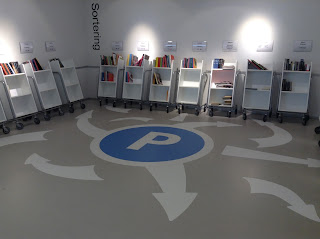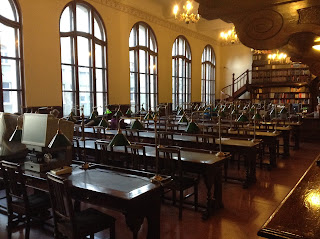Moss Bibliotek - Norway
This outside of Moss Library is reminiscent of the Granary Building in London's King's Cross, the front of which has itself been converted into a library (part of a Central St Martin's College of Art campus at the site).
Children can conduct their own experiments in this science area!
We visited Moss in the afternoon of the first day. Having encountered driving rain ever since we set off from Oslo, this archetypal "living room" of a library was a real gem to sit and revive ourselves in...if only for a short while (we had a ferry to catch to Horten, where it rained. Hard. Again!!). The library hosts coffee mornings, language classes and arts & crafts groups, amongst other events in this welcoming space.
One of many snug nooks and crannies at Moss Library
The library's website is also well worth a look and includes the option to translate into some 80 different languages!
Stadsbiblioteket Göteborg - Sweden
Did I mention already that it rained quite a bit during the early part of the tour?
Gothenburg's central library is something of a treasure trove. The mix of furniture is remarkable, from areas which looked as if they were straight out of a 70s B-movie set to space-aged spinning top chairs (as seen at Helsingør library) and ergonomic recliners:
Bold furniture and carpets in the journals area!
Some übercool MAGIS Spun Chairs and rolling shelving in the lobby
This large events space greets visitors as they enter the vast Gothenburg library
The Dynamo area takes pride of place on the ground floor. It's effectively a 3,700 square metre sanctuary for roaming adolescents, where those with time on their hands can meet and play video games together! There is a "Dynamo Game" and a "Dynamo Read" section whcih includes materials on film, comics and manga as well as games.
Gothenburg City Library also boasts this enchanting storytelling this
Hjørring Bibliotek - Denmark
Sited within a shopping centre and completed in just 7 months (incredibly!) this is a library which is all about encouraging interaction...and fun!
An omnipresent red line creates a literal thread through the library. The is one of the features spawned out of using artists as designers on this project, in conjunction with librarians. Urban sociologists were also called in when the building was established in 2008 to turn this retail area into a third place (as Ray Oldenburg describes them) between work and home.
A parking bay for book trolleys!
(Whatever with those Danes think of next?!)
(Whatever with those Danes think of next?!)
An omnipresent red line creates a literal thread through the library. The is one of the features spawned out of using artists as designers on this project, in conjunction with librarians. Urban sociologists were also called in when the building was established in 2008 to turn this retail area into a third place (as Ray Oldenburg describes them) between work and home.
The red line leads users along a path around the building...
...and it is also used to highlight themes throughout the library!
Most of the library's 5,100 square metres has been designed with families in mind. There are slides hidden within the book stacks and all manner of other miniature play areas for those who are tiny enough to explore and enjoy! There is also a "Very Important Parents" section to relax in and one or two more secluded, quiet spaces for adults too, as well as a 'living room' area with screens showing news feeds, bus timetables and other relevant information.
Another innovative feature I spotted was the use of iPads attached to shelving trolleys - these can, for instance, be pre-loaded up with images and shelfmark details of books for staff to collect from picking lists. Thus making life that little bit easier for everyone!...
 |
| Even the staff area is brilliant! Check out the massage chair on the left!! |
Randers Bibliotek - Denmark
This library sits inside a larger "Kulturhuset" (culture house), sharing its space with a local archive, museum, an art gallery and performance space. It is a Brutalist building but the imposing concrete structure is skilfully softened through clever lighting and homely finishings around the building.
The children & teenagers' area at Randers
The library also boasts one of the snazziest book sorting units I've seen, complete with mechanical tilting trolleys:
I feel it is a library which perhaps epitomises what the Danes call "Hygge" - a word not easily translatable but is described approximately in this article as a sort of "cosiness of the soul".
A guitar/double bass combo played for us on the main stage!
Dokk1 - Denmark
A brand new, huge publicly funded space on the docks of Aarhus. This library is the largest in Scandinavia (and all of the Nordic countries in fact) and forms a key part of plans to convert this area of the city from industrial to knowledge space. The aim was to create building to last for 100 years. An important part of that was to create as much flexibility as possible in the space. Everything within the building can be removed easily and it is described as an "intelligent" building, with a Class 1 environmental rating.
Some 300,000 parts were moved from the old Aarhus library
The expectation is that Dokk1 will receive some 4-5,000 visitors every day!
Described as a "media house", this behemoth occupies some 30,000 square metres, 10,000 of which can be rented out. It is also home to a train station (located underneath one of the main staircases) and an automated car park - essentially an Automated Storage and Retrieval System (ASRS) for cars!
Hi-tech conference rooms can be adjusted acoustically
according to the type of event happening in these spaces
Large video screens broadcast tweets with the hashtag "#dokk1"
Architects Hammer Lessen set out to create this building with no obvious front or back, with as many open spaces as possible to create opportunities for interactions and knowledge exchange. These include exhibitions, workshops, gaming and events. Immediately outside is the building's "podium" space - an area with climbing frames, slides and other playground apparatus. Rather cutely, these are used to represent the direction in which that particular side of Dokk's 'star' shape the area is pointing towards (the side pointing East to Russia has a large bear, for instance...look in a south-westerly direction towards the US and you'll see a bald eagle!).
Designers have included many nods to the city's maritime heritage
Dokk1 includes the largest tubular bell in the world which
rings each time a baby is born at Aarhus hospital!
It being Denmark, of course there was LEGO!
These have just been some of my personal highlights. To sum it all up (and without getting too schmaltzy...) nothing gives so much energy, motivation and passion for what I do as the tours I do with Cycling for Libraries. Keeping that going through the relative monotony of life back on 'civvy street', with all of its frustrations, uncertainties and setbacks can sometimes be far more difficult than pushing through kilometre after kilometre of biking. The next tour may well take place outside of Europe for the first time, potentially ending at IFLA 2016 in Ohio! I'll certainly do all I can to be there.
If you want to see more from the Cycling for Libraries 2015 tour, there is loads of stuff on the www.cyclingforlibraries.org website! We received a lot of media coverage along the route, particularly once we got to Denmark (for instance at one stage a TV cameraman followed us around with his camera on his shoulder as he cycled along with us!). Examples of video reports can be found here (via Kjeld Jensen) and here (via Viborg Folkeblad).
A big thank you has to go to everyone involved in organising the tour, as well as to the sponsors; the seminar we had during our ferry ride between Gothenburg and Fredrikshavn all about skills & competencies required of library & information professionals was especially useful and was kindly funded by DIK, the Swedish professional association and trade union for librarians. A special thank you also goes to Lyngsoe Systems who sent this photo (taken in their backyard!) to all the participants when we got home!
Image reference:
Lyngsoe Systems [via Cycling for Libraries!] (2015) Cyc4lib 2015 tour at the yard of the tour sponsor. Thanks a lot! [Facebook] 25 September. Online at:
https://www.facebook.com/cyc4lib?fref=ts [Accessed 28.09.15]













































